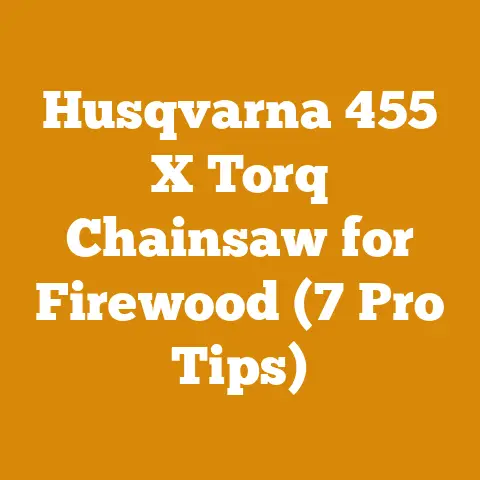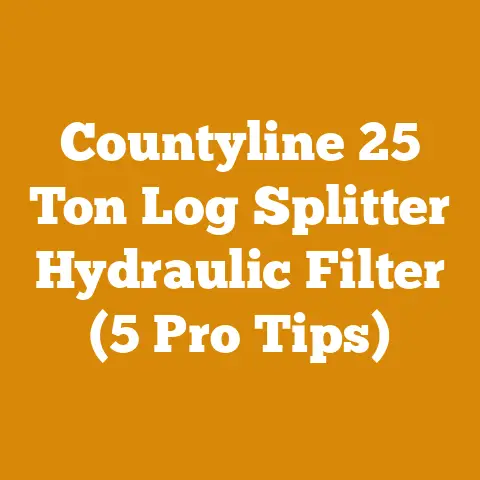Will Termites Eat Live Trees? (5 Signs Every Arborist Knows)
Can termites really turn a majestic, living tree into their personal buffet? It’s a question that strikes fear into the heart of any arborist or homeowner who values the health and longevity of their trees. The short answer is yes, but the story is much more nuanced than a simple “yes” or “no.” Let’s dive deep into the world of termites and trees, separating fact from fiction and equipping you with the knowledge to protect your arboreal assets.
But their relationship with live trees is more complex. While they are notorious for feeding on deadwood, their interaction with living trees is not always straightforward.
Termites: More Than Just Wood Eaters
Before we delve into their dining habits, let’s understand what termites are. They are social insects, living in colonies, and play a vital role in ecosystems by breaking down dead plant material, recycling nutrients back into the soil. There are several types of termites, each with its own preference for food.
The Primary Target: Deadwood
Termites primarily feed on cellulose, the main component of wood. Deadwood, whether it’s fallen branches, decaying stumps, or structural timber in buildings, is their preferred food source. This is because deadwood is easier to digest and provides a readily available source of nutrients.
When Live Trees Become a Target
While termites prefer deadwood, they can and sometimes do attack live trees. This usually happens when the tree is already weakened, stressed, or has existing decay. Termites are opportunists, and a compromised tree presents an easier target than a healthy one.
Understanding the Threat: Types of Termites Involved
Not all termites are created equal. Different species have different habits and preferences, and some are more likely to attack live trees than others.
Subterranean Termites: The Underground Invaders
Subterranean termites are the most common and destructive type of termite. They live in underground colonies and build mud tubes to reach their food source, which can be deadwood or, in some cases, live trees. These termites are particularly problematic because they can access trees through the soil, often attacking the root system or the base of the trunk.
Drywood Termites: The Independent Settlers
Drywood termites, on the other hand, live within the wood they consume and don’t require contact with the soil. They are less likely to attack live trees, as they prefer dry, seasoned wood. However, if a tree has a significant amount of deadwood or dry rot, they might move in.
Dampwood Termites: The Moisture Seekers
Dampwood termites are attracted to wood with high moisture content. They are more likely to be found in decaying wood or trees that are constantly wet or waterlogged. While they can attack live trees, they typically target those with existing rot or decay.
5 Signs Every Arborist Knows: Identifying Termite Infestation in Live Trees
Detecting termite infestation in live trees can be tricky, as they often work from the inside out. However, there are several telltale signs that an arborist (and any vigilant homeowner) can look for.
1. Mud Tubes: The Termite Highways
One of the most obvious signs of subterranean termite activity is the presence of mud tubes. These are small, earthen tunnels that termites build to travel from their underground colonies to their food source. They are often found on the trunk of the tree, especially near the base, or along exposed roots.
My Experience: I once inspected a mature oak tree that appeared healthy from a distance. However, upon closer inspection, I discovered several mud tubes running up the trunk, hidden beneath a thick layer of ivy. Removing the ivy revealed the extent of the termite infestation, which had severely weakened the tree’s base.
2. Frass: The Termite Droppings
Drywood termites leave behind small, granular droppings called frass. This frass is often found near entry points or in piles at the base of the tree. The color of the frass can vary depending on the type of wood the termites are consuming.
A Word of Caution: Don’t confuse termite frass with sawdust from wood-boring beetles. Termite frass is typically smaller and more uniform in size and shape.
3. Hollow Sounds: The Silent Damage
Termites eat wood from the inside out, often leaving the outer layers intact. This can create hollow areas within the tree. You can sometimes detect these hollow areas by tapping on the trunk with a rubber mallet or a blunt object. A hollow sound indicates that the wood is likely damaged or infested.
Case Study: I was called to assess a large maple tree that was showing signs of decline. The leaves were yellowing, and the branches were thinning. When I tapped on the trunk, I heard a distinct hollow sound. Upon further investigation, I discovered that termites had hollowed out a significant portion of the tree’s interior, making it structurally unstable.
4. Visible Damage: The Obvious Signs
In some cases, the damage caused by termites may be visible on the exterior of the tree. This can include:
- Soft spots or areas of decay: These areas may be soft to the touch or crumble easily.
- Blisters or raised areas on the bark: These can indicate termite activity beneath the bark.
- Exit holes: These are small holes where termites have exited the tree.
- Unexplained dieback: Sudden or unexplained dieback of branches can be a sign of termite infestation.
5. Changes in Tree Vigor: The Subtle Clues
Termite infestation can weaken a tree, making it more susceptible to disease and stress. This can manifest in several ways:
- Yellowing or browning leaves: This can indicate that the tree is not getting enough nutrients or water.
- Thinning canopy: A thinning canopy means that the tree is losing leaves and branches.
- Stunted growth: If the tree is not growing as quickly as it should be, it could be a sign of underlying problems.
- Increased susceptibility to disease and pests: A weakened tree is more vulnerable to other problems.
Protecting Your Trees: Prevention and Treatment Strategies
Preventing termite infestation is always the best approach. However, if you suspect that your trees are already infested, there are several treatment options available.
Prevention Strategies: A Proactive Approach
- Maintain Tree Health: Healthy trees are more resistant to termite infestation. Provide adequate water, fertilizer, and pruning to keep your trees strong and vigorous.
- Remove Deadwood: Remove any dead or decaying branches, stumps, or roots from around your trees. This eliminates a potential food source for termites.
- Improve Drainage: Ensure that the soil around your trees is well-drained. Termites are attracted to moist environments.
- Mulch Properly: Avoid piling mulch directly against the trunk of the tree. This can create a moist environment that attracts termites.
- Regular Inspections: Regularly inspect your trees for signs of termite infestation. The earlier you detect a problem, the easier it will be to treat.
My Tip: I always recommend creating a “termite-free zone” around the base of your trees. This involves removing any vegetation, debris, or mulch within a few feet of the trunk.
Treatment Options: Addressing Existing Infestations
If you discover that your trees are infested with termites, there are several treatment options available.
- Soil Treatment: Soil treatments involve applying a termiticide to the soil around the tree. This creates a barrier that prevents termites from accessing the tree.
- Direct Wood Treatment: Direct wood treatments involve injecting a termiticide directly into the infested wood. This can be effective for treating localized infestations.
- Baiting Systems: Baiting systems involve placing termite bait stations around the tree. The termites consume the bait and carry it back to their colony, eventually eliminating the entire colony.
- Professional Arborist Consultation: In severe cases, it may be necessary to consult with a professional arborist. They can assess the extent of the damage and recommend the best course of treatment.
Important Note: When using termiticides, always follow the manufacturer’s instructions carefully. Wear appropriate protective gear and take precautions to avoid contaminating the environment.
The Role of Wood Condition: Understanding the Attractiveness Factor
The condition of the wood plays a significant role in whether termites will attack a live tree.
Healthy Wood: A Natural Defense
Healthy wood contains natural defenses that make it less attractive to termites. These defenses include:
- Hardness: Dense, hard wood is more difficult for termites to chew and digest.
- Resins and Oils: Some trees contain resins and oils that are toxic to termites.
- Moisture Content: Termites prefer wood with a specific moisture content. Wood that is too dry or too wet is less attractive to them.
Compromised Wood: An Open Invitation
Compromised wood, on the other hand, is more susceptible to termite attack. This includes wood that is:
- Decaying: Decaying wood is softer and easier to digest.
- Damaged: Damaged wood provides entry points for termites.
- Stressed: Stressed trees produce less defensive compounds.
- Diseased: Diseased wood is often weakened and more susceptible to attack.
Tree Species and Termite Susceptibility: Knowing Your Trees
Some tree species are more susceptible to termite infestation than others. This is due to differences in wood density, resin content, and other factors.
Resistant Species: The Fortified Trees
Some tree species are naturally resistant to termite attack. These include:
- Redwood: Redwood contains natural oils that are toxic to termites.
- Cedar: Cedar also contains natural oils that repel termites.
- Cypress: Cypress is resistant to decay and termite attack.
- Black Walnut: Black walnut is a hard, dense wood that is difficult for termites to chew.
Susceptible Species: The Vulnerable Trees
Other tree species are more susceptible to termite attack. These include:
- Pine: Pine is a soft wood that is easy for termites to digest.
- Poplar: Poplar is a fast-growing tree with soft wood.
- Willow: Willow is a moisture-loving tree that is susceptible to decay.
- Fruit Trees: Many fruit trees are susceptible to termite attack, especially when they are stressed or diseased.
My Observation: I’ve noticed that fruit trees, particularly those that are not properly pruned or fertilized, are often the first trees to be attacked by termites in a landscape.
The Impact of Environmental Factors: The Bigger Picture
Environmental factors can also play a role in termite infestation.
Moisture: A Termite Magnet
Termites are attracted to moist environments. Areas with high humidity, poor drainage, or excessive rainfall are more likely to experience termite problems.
Soil Contact: The Underground Connection
Trees that are in direct contact with the soil are more vulnerable to subterranean termite attack. This is because termites can easily access the tree from the ground.
Climate: The Geographical Influence
Climate can also affect termite activity. Termites are more active in warm, humid climates.
Beyond the Tree: Protecting Your Property
Termites don’t just attack trees. They can also damage your home and other wooden structures on your property.
Extending the Protection Zone
It’s important to protect your entire property from termite infestation, not just your trees. This includes:
- Regular Inspections: Have your home inspected for termites regularly.
- Proper Drainage: Ensure that your home has proper drainage to prevent moisture buildup.
- Remove Wood Debris: Remove any wood debris from around your home.
- Seal Cracks and Crevices: Seal any cracks and crevices in your foundation to prevent termites from entering your home.
Working with Professionals
If you suspect that you have a termite problem, it’s best to consult with a professional pest control company. They can identify the type of termite, assess the extent of the damage, and recommend the best course of treatment.
Case Studies: Real-World Examples of Termite Damage
To illustrate the impact of termite infestation on live trees, let’s examine a few case studies.
Case Study 1: The Dying Oak
A homeowner noticed that their mature oak tree was starting to decline. The leaves were yellowing, and the branches were thinning. Upon closer inspection, an arborist discovered mud tubes running up the trunk of the tree. The arborist determined that the tree was infested with subterranean termites. The termites had damaged the root system and the base of the trunk, weakening the tree and making it susceptible to disease. Despite treatment, the tree eventually died and had to be removed.
Case Study 2: The Hollow Maple
A property manager was concerned about the safety of a large maple tree near a building. The tree appeared healthy from a distance, but the property manager noticed a hollow sound when tapping on the trunk. An arborist investigated and discovered that termites had hollowed out a significant portion of the tree’s interior. The tree was deemed a safety hazard and had to be removed.
Case Study 3: The Infested Fruit Tree
A homeowner noticed that their apple tree was not producing as much fruit as it used to. The leaves were also yellowing, and the branches were dying back. An arborist discovered that the tree was infested with drywood termites. The termites had damaged the branches and the trunk, weakening the tree and reducing its fruit production. The arborist treated the tree with a direct wood treatment, which helped to control the infestation and improve the tree’s health.
The Future of Termite Control: Emerging Technologies
The field of termite control is constantly evolving. Researchers are developing new and innovative technologies to combat these pests.
Biological Control Agents
Biological control agents are natural enemies of termites, such as fungi, nematodes, and bacteria. These agents can be used to control termite populations without the use of harmful chemicals.
Improved Termiticides
Researchers are also developing new termiticides that are more effective and less harmful to the environment. These termiticides are designed to target termites specifically, while minimizing the impact on other organisms.
Monitoring Technologies
New monitoring technologies are being developed to detect termite activity early on. These technologies include acoustic sensors, infrared cameras, and electronic sniffing devices.
Final Thoughts: Protecting Our Trees for Future Generations
Termites can pose a significant threat to live trees, but with knowledge and vigilance, we can protect our arboreal assets. By understanding the signs of termite infestation, implementing preventative measures, and seeking professional help when needed, we can ensure that our trees remain healthy and vibrant for generations to come.
Remember, a healthy tree is a valuable asset, providing shade, beauty, and ecological benefits. By taking proactive steps to protect our trees from termites, we are investing in the future of our environment.






